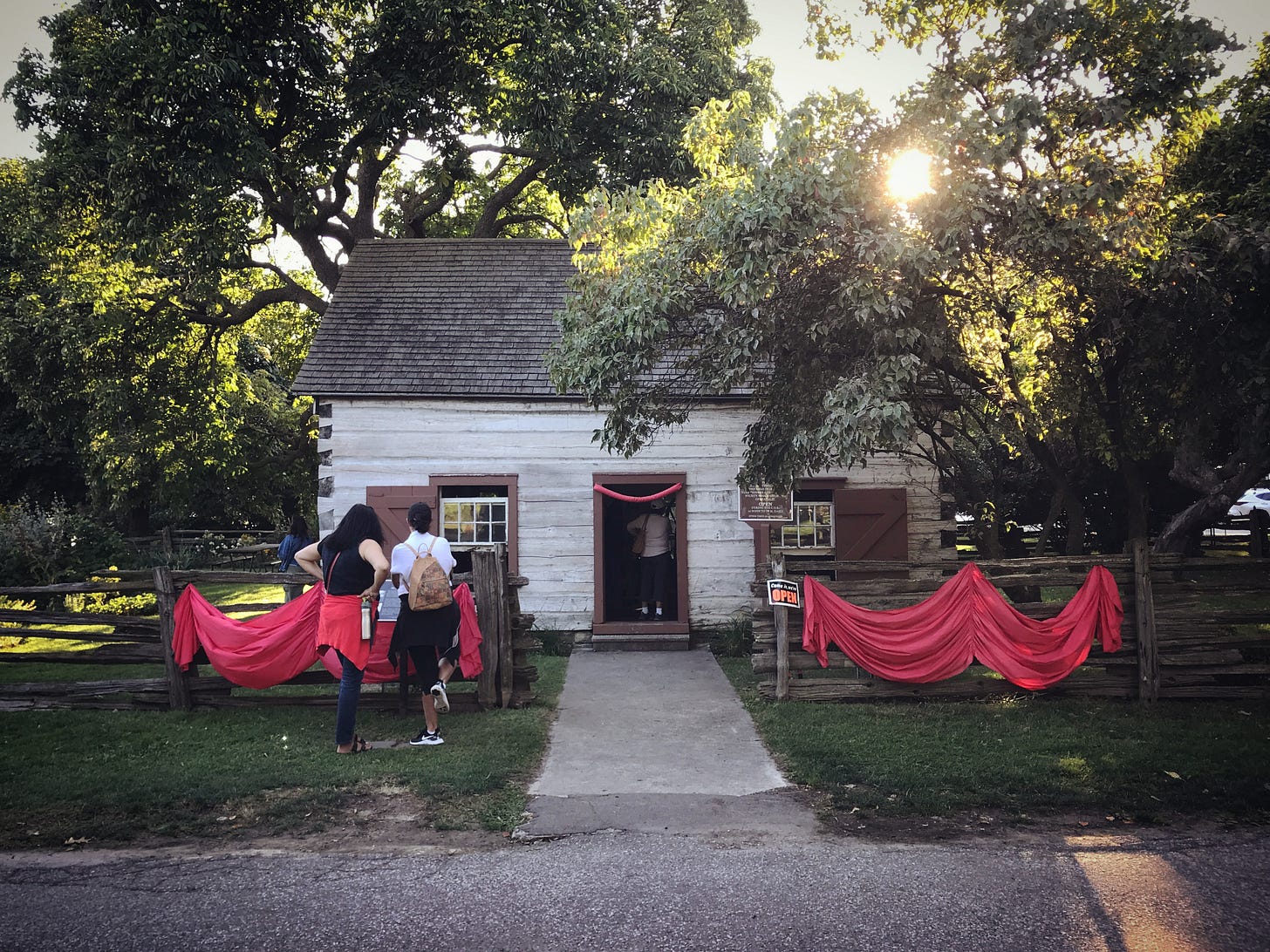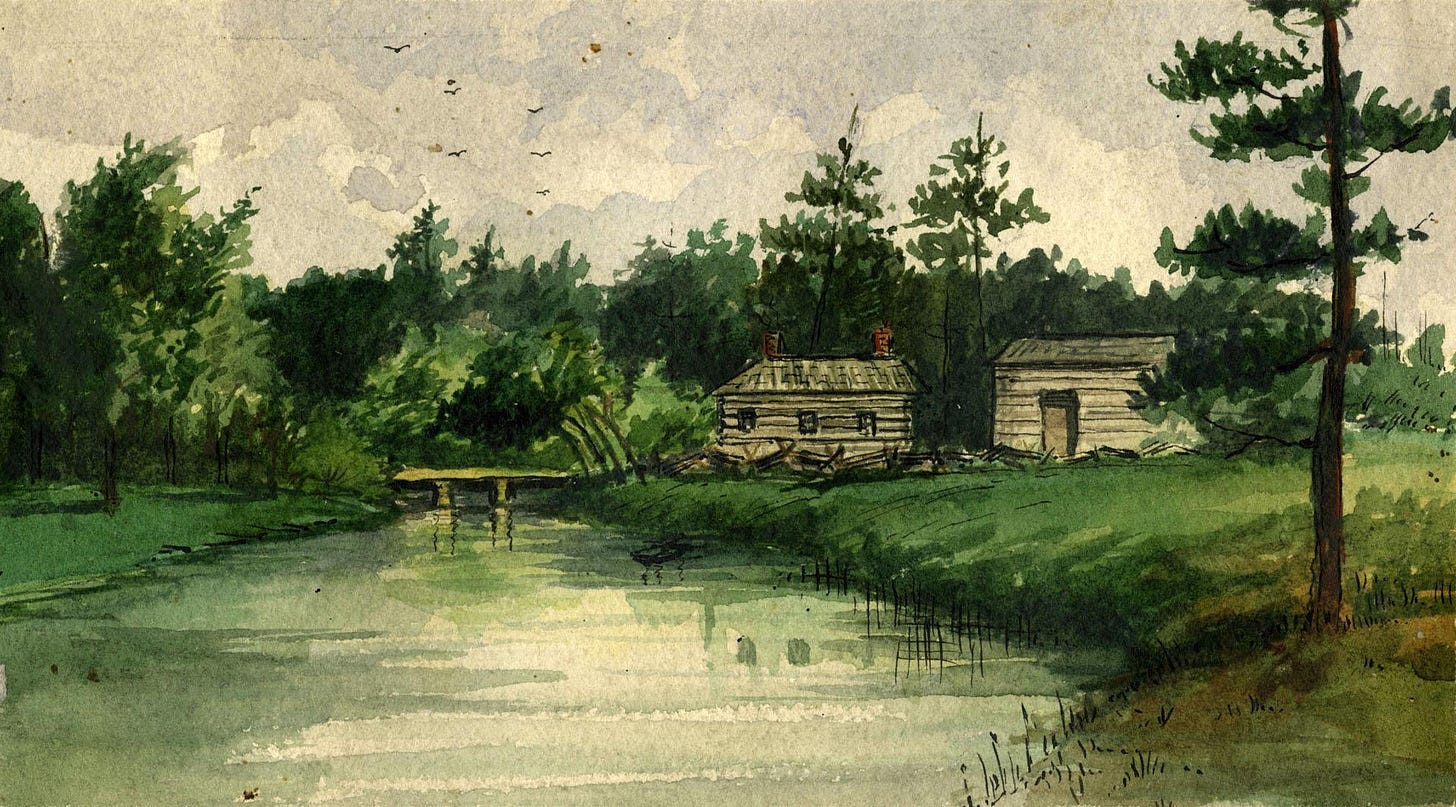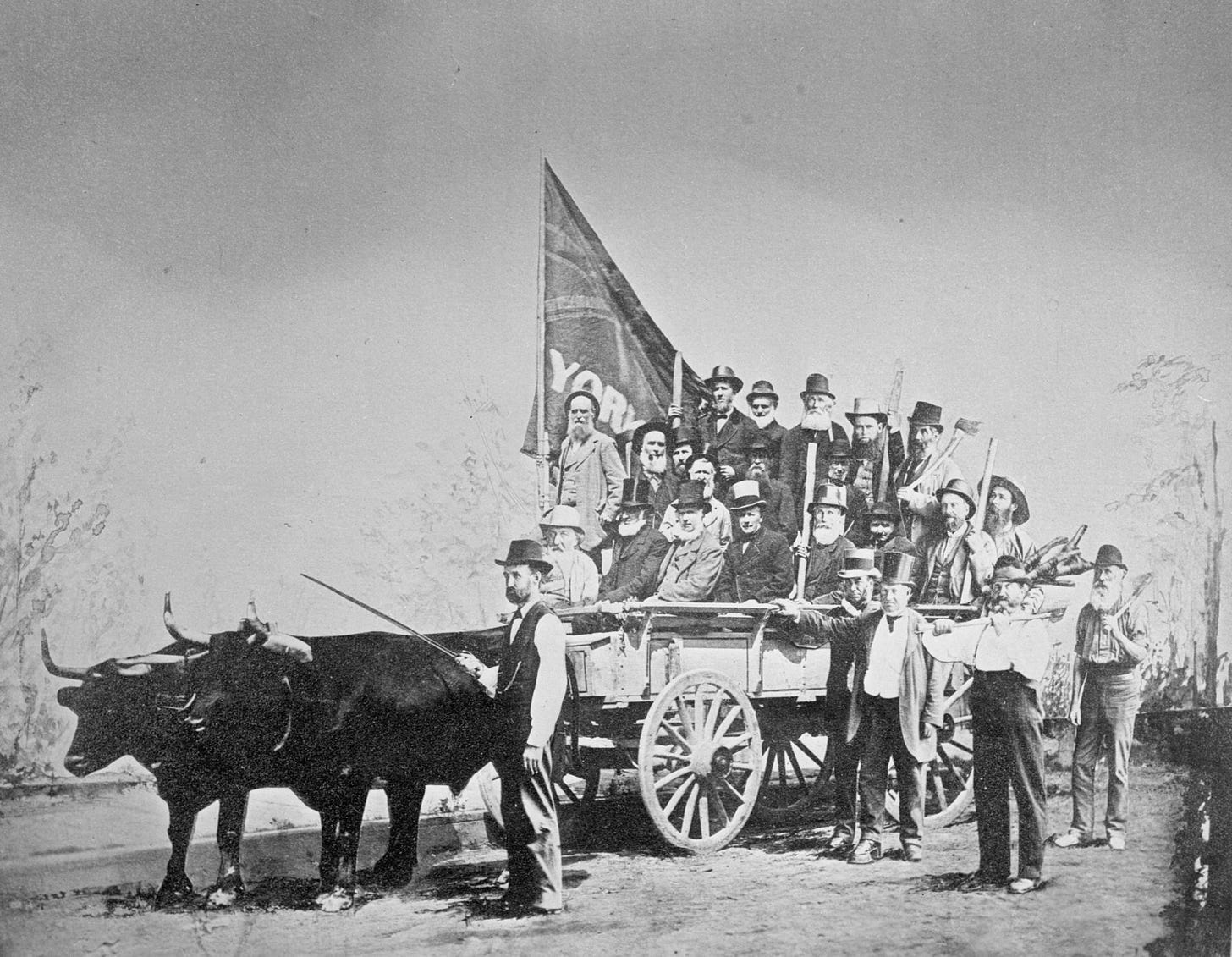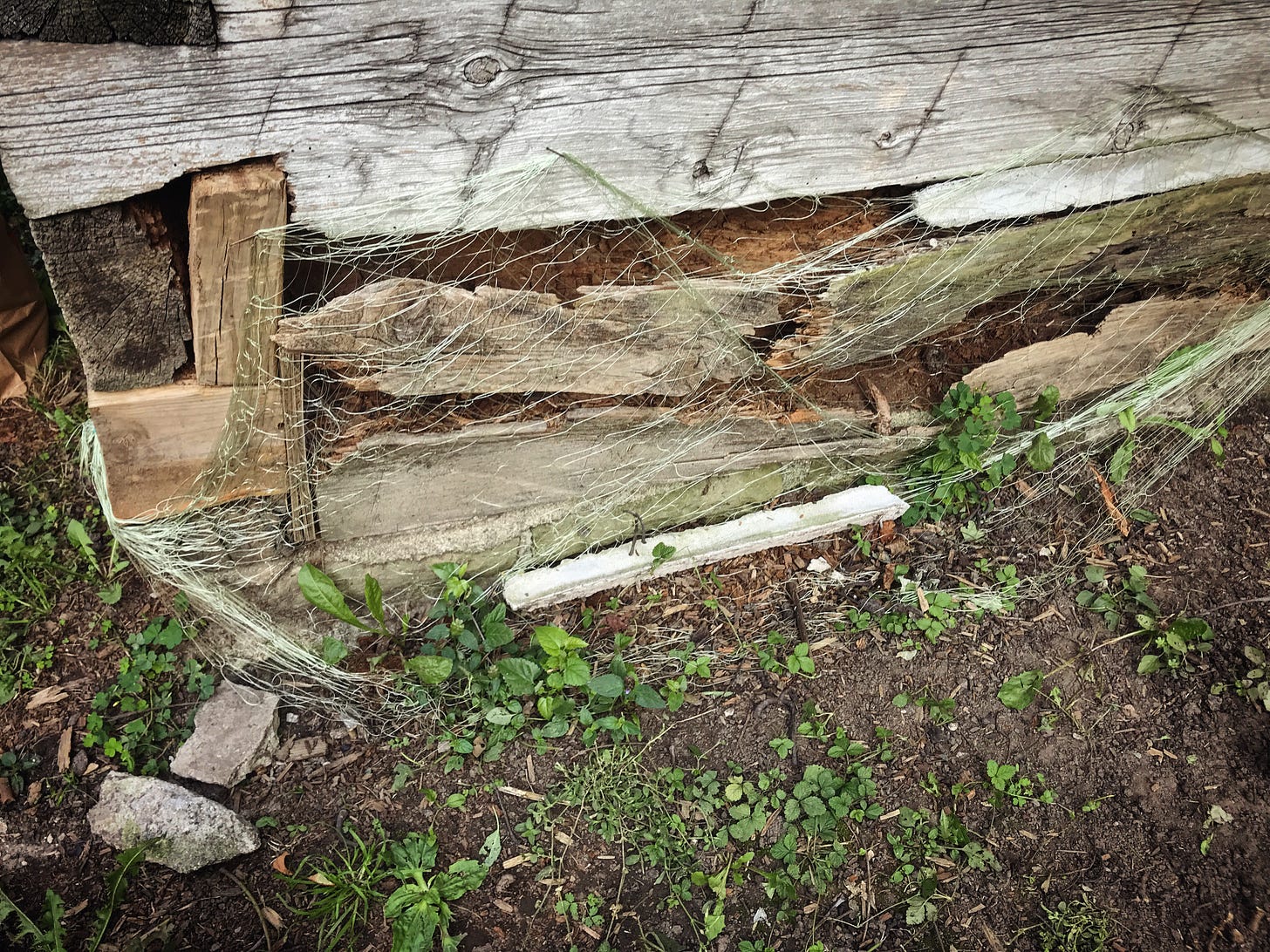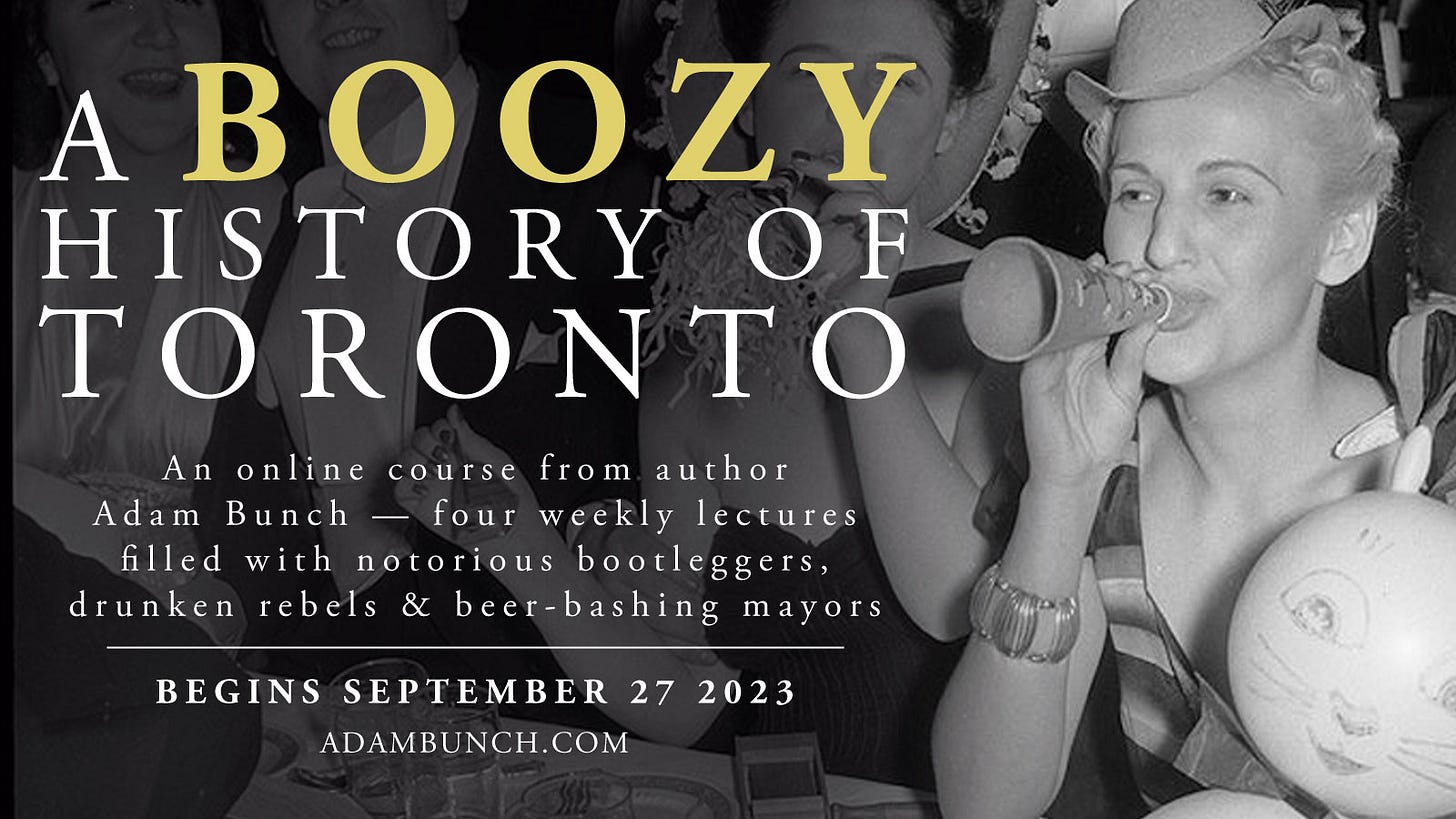Toronto's Oldest Building Is In Trouble
Plus: free beer, boozy history and more...
It stood on the banks of the Don River for nearly a century: a small log cabin, built in 1794 — just a year after the first British settlers arrived in this place. It was made from the trunks of white pines, trees from the ancient forest that once covered the land where our city now stands. Those woods had been carefully managed for countless generations by the First Nations who’d already been living here for thousands and thousands of years. And when the cabin was first built, it was still surrounded by that towering forest; it sat about a kilometre outside the muddy little frontier town which the British were building on the shore of the lake.
The cabin belonged to a man named John Scadding. He served as clerk to the founder of Toronto, John Graves Simcoe. He assisted Simcoe as the lieutenant-governor oversaw the construction of the new colony, the building of forts and roads, the granting of land to settlers. Years earlier, the British had negotiated a treaty with the Mississaugas. And while Simcoe soon discovered that the Toronto Purchase was basically fraudulent — nothing more than a blank deed that didn’t even describe the land that had been discussed — as far as he and his bosses were concerned, it was all they needed to build a city in this place… and to hand over big parcels of land to newly-arrived settlers.
Scadding was granted a plot running down the eastern bank of the Don River — everything from the Danforth all the way south to the lake. It was a place filled with forests, wetlands and wildflowers, home to bears, wolves and moose — there were even reports of mountain lions. Enormous flocks of passenger pigeons soared by in the spring and fall, their colourful feathers catching the light as they migrated up and down the valley by the millions, taking hours to pass by. He built his cabin toward the southern end of his land — on the spot where Queen Street meets the Don today. A small footbridge crossed the river nearby. The vast Ashbridge’s Marsh was just a short walk away. And when a road to Kingston was built right past the cabin, the log house became an especially familiar local landmark; it was the first building on the way out of town.
Scadding wouldn’t live there long, though. When Simcoe headed home to England just a few years later, Scadding went with him; he was the manager of the family’s country estate back in Devon. And while he would eventually return to Toronto after Simcoe died, by then he had a whole family with him.
During those years in England, Scadding had married a woman named Melicent Triggs. They had three sons. That little log cabin was far too small for a family of five. So instead, they moved into a much bigger log farmhouse that he’d built on the spot where the Don Jail is now, perched atop the valley edge and surrounded by tall pines.
Scadding had a reputation as an excellent farmer, hailed as “one of the best informed agriculturalists in England.” And he would turn his land in Toronto into farmland, too. He carved space out of the forest for fields of wheat, barley and rye, along with what was likely the city’s first rhubarb and some of the maize that settlers had learned to grow from the First Nations. Great old oaks and pines came crashing to the ground, making way for orchards filled with apple trees and peach trees. Marshes were turned into meadows where sheep grazed.
It was the work of clearing his land that would kill him. On a late winter afternoon in 1824, Scadding was on his way home when he decided to check in on some men he’d hired to fell trees on his property. But as he stopped to give them a bit of advice, he chose to stand in the wrong spot. One of the trunks was already nearly chopped all the way through… and as Scadding talked with the workers, the tree suddenly came crashing down. He didn’t have time to get out of the way.
Scadding’s youngest son was walking home from school when he saw his wounded father being carried into town on a sleigh. Henry was just ten years old, already a promising young scholar. One of the men gave him the terrible news, quickly followed by the sight of the doctor hurrying along the street with an array of medical instruments under his arm. “I rushed home and told my mother,” Henry later remembered, “but when she reached the town life was extinct. Never shall I forget her anguish or my own feelings as she told me on her return that I had no father.”
Henry Scadding would continue his studies and make good on his scholarly promise. He went on to become the first student ever enrolled at Upper Canada College and grew up to serve as the priest at Holy Trinity (the church you’ll still find hidden away behind the Eaton Centre). He would also develop a passionate interest in Toronto’s past, becoming one of its preeminent historians. He co-founded the city’s first historical society, the York Pioneers, serving as its first president. And it’s thanks in part to him that his father’s log cabin is still around today.
John Scadding had sold the land where the cabin stood to build his family their new, bigger home. And in the decades to come, the city would swallow up that little log house. By the end of the 1870s, the population of Toronto was nearing 100,000 people — and more were arriving all the time. The first railroads had been built; one of them ran within a few hundred metres of the cabin, trains rumbling by where wolves had once roamed. The roads were filling with streetcars and bicycles. New office blocks were going up. One Toronto restaurant had even been equipped with electricity. The land around the cabin was beginning to be subdivided into today’s residential neighbourhoods while the banks of the Don River were attracting factories that poured pollution into the once fresh water. Coal smoke hung thick in the air.
Much of the old Scadding farm had been demolished by then. But the cabin had survived all the upheaval. And the building’s new owner knew how remarkable an artifact it was. John Smith was the son of the man who had bought the land from John Scadding back in the early 1800s and as a member of the York Pioneers himself, he hoped to see the old log cabin preserved.
So, he offered it as a gift to the Pioneers. They accepted, with a plan to move it somewhere safe and accessible, where it could be enjoyed by future generations. They knew just where to put it.
The roots of the Canadian National Exhibition stretch all the way back into the middle of the 1800s, to a small agricultural fair that toured around the province, moving from one city to another each year. But in 1879, the same year John Smith decided to give Scadding Cabin to the York Pioneers, Toronto decided to host its own annual fair on an ongoing basis. That’s when the CNE was officially born — hosted on the exhibition grounds specifically reserved for the event, with nearly two dozen permanent buildings and thousands of exhibits. The Ex drew more than 100,000 visitors in its first year, more than the entire population of the city. And John Scadding’s log cabin was one of the big attractions.
The York Pioneers had dismantled the cabin and transported the pieces to the Exhibition Grounds — some say they were floated down the Don River and then west along the lake shore. There, they quickly rebuilt the little house in its new home. It arrived just a couple of weeks before that first edition of the CNE opened and it has stood there ever since.
So, more than 200 years after it was first built, you can still visit the cabin yourself. It stands on a quiet spot behind the bandshell, near the base of the modern windmill that towers above the grounds and next to a monument remembering the French fort that stood on the spot in the middle of the 1700s. The York Pioneer and Historical Society still looks after the cabin today. And during the CNE, they open the little building to the public so you can take a peek inside.
But this year, there’s been some worrying news. They recently announced that Scadding Cabin is in trouble. The wee building has faced down many dangers over the years. A few decades ago, it was carpenter ants infesting the logs, threatening to destroy the entire building if left unchecked. Back then, members of the public helped raise $15,000 to save the cabin. Now, the enemy is rot; it’s eating away at some of the logs on one of the corners of the building, threatening the centuries-old cabin once again. As the York Pioneers explain, “Significant restoration work must quickly be undertaken to prevent long-term damage.” Protecting Scadding Cabin will costs thousands of dollars. So, the organization has put out another call for help, asking the public for donations.
You can find more about Scadding Cabin from the York Pioneer and Historical Society here, from the Achitectural Conservancy of Ontario here, from John Ross Robertson’s “Landmarks of Toronto” here, and Mike Filey’s “Toronto Sketches: The Way We Were” here. You can find out more about the Scadding family and John Scadding’s fatal accident in “The Scaddings, A Pioneer Family in York” by T.A. Reed here.
Free Beer! And The Boozy History of Toronto…
In much happier news, I’m bringing back one of my most popular online courses — and this time it comes with free beer!
Alcohol has always been a dramatic part of life in Toronto — from the days of colonial treachery to modern debates over drinking in parks. In this four-week online course, we'll meet drunken rebels, beer-bashing mayors, notorious bootleggers, and alcoholic politicians. We'll witness booze-soaked murders, prohibition-era shootouts, and the kidnapping of one Canada's wealthiest brewers — plus, the bitter fight over whether drinking should be allowed at all. To truly understand Toronto, it helps to understand how this city has been shaped by centuries of people getting drunk.
The course is being sponsored by the wonderful people at Great Lakes Brewery, who got in touch asking if they could give the students free beer! Of course I said yes! So, if you’re logging in from Toronto, you’ll get a grand total of eight free beers to go along with the course — two for each class. (And if you’d like to do a little of your own research ahead of time so you know what kind of tasty beer you’re in for, you can check out the Great Lakes Brewpub at 11 Lower Jarvis or find them on offer in bars and restaurants around the city.)
The course begins September 27 and runs for four Wednesday nights. And as always, paid subscribers to the newsletter get 10% off!
Thank you so much to those of you who have already made the switch to a paid subscription! It’s because of you that The Toronto History Weekly exists. The newsletter is a ton of work, but with every new paid subscriber it gets a little bit closer to being self-sustaining. We’re not quite there yet, but it’s not far off! If you haven’t already become one of the absolutely wonderful people who support The Toronto History Weekly with a few dollars a month, but would like to… you can do it by clicking right here:
QUICK LINKS
The best of everything else that’s new in Toronto’s past…
OUR ENEMY, VINEGAR SYNDROME NEWS — The rot in the logs of Scadding Cabin isn’t the only physical danger to Toronto’s history right now. Vinegar syndrome is threatening to wipe out historic newspaper collections at the Toronto Reference Library, an incredibly vital record of our city’s history. Staff discovered the problem while it was still in the early stages and are racing to save the collections, sorting through hundreds of thousands of microfiches and microfilm reels to figure out which ones are at risk and then copy them over to a more resilient format. Read more.
HOUSES THAT DIDN’T GET BURNED DOWN TWO CENTURIES AGO NEWS — Misha Gajewski takes us inside the Joseph Shepard House. Built in the 1830s, it’s “one of the few remaining homes to have a direct link to the 1837 Upper Canada Rebellion… According to Toronto Public Library, Shepard's sons and wife participated in the rebellion and historians believe that soldiers tried to burn down the house.” Read more.
WORTH SAVING NEWS — Speaking of threatened heritage… Toronto Life shares “a nostalgic tour” of Ontario Place as battles over the future of the site (whether to hand it over to a massive, private spa or allow it to continue as a beloved public park) rage on. Read more.
DEAD TRANSIT LINE NEWS — With the news that the Scarborough RT will never be coming back into service, Jamie Bradburn digs into his archives to share the story of how it came to be in the first place. Read more.
TORONTO HISTORY EVENTS
EXPLORING EMANCIPATION
Until August 31 — Wed (11–5pm), Thurs to Sun (11–5pm) — Todmorden Mills — The East York Historical Society
“Todmorden Mills hosts a community display by the East York Historical Society on the theme of “Exploring Emancipation” for August Emancipation Month. Visitors to this intimate exhibit will learn about the history of Emancipation through images, artefacts and essays from East York Historical Society members and affiliates.”
Free!
SCADDING CABIN AT THE CNE
Until September 4 — 12pm to 7pm daily — Scadding Cabin on the Exhibition Grounds — York Pioneer and Historical Society
Explore the oldest building in Toronto with various exhibits, artifacts, activities, speakers, and performers being offered throughout the afternoons and evenings during the Ex.
Free with admission to the CNE!
AUTHOR SERIES: MURDER IN RICHMOND HILL
September 7 — 7pm — Toronto’s First Post Office — 260 Adelaide Street East
“David Raymont will present on his editorial review of William Harrison’s Memoirs that focus on the true story of the Richmond Hill Murders of 1843; the historic event that would later inspire Margaret Atwood’s novel, “Alias Grace.” By focusing on contemporary accounts and using a variety of primary sources, Raymont uncovers an intriguing history full of twists and turns while presenting the social aspects of public opinion towards single parents and domestic work in 1840s Ontario. This event is part of our Annual Fall Author Series featuring four acclaimed Canadian historical fiction and non-fiction authors!”
$22.63 for non-members; $17.31 for members
BOOK LAUNCH — TORONTO MAYORS: A HISTORY OF THE CITY’S LEADERS
September 11 — 5:30pm — Old City Hall (Main Lobby)
“Join Mark Maloney in celebrating the launch of his new book, Toronto Mayors, in the Old City Hall. The first-ever look at all 65 Toronto mayors — the good, the bad, the colourful, the rogues, and the leaders — who have shaped the city… Toronto’s mayors have been curious, eccentric, or offbeat; others have been rebellious, swaggering, or alcoholic. Some were bigots, bullies, refugees, war heroes, social crusaders, or bon vivants; still others were inspiring, forward looking, or well ahead of their time.”
$40 (including a copy of the book)
SPACIOUSNESS
Various dates between Sept 13 Oct 7 — 7pm — Fort York
“Spaciousness is a compelling new theatrical experience that offers a tour like no other. Be transported to the past to encounter a multitude of characters who bring to life expansive stories of love, life, and loss during the War of 1812. Then be brought back to present day with a story of surviving conflict that encourages us towards peace. Traverse the grounds of Fort York and meet a cast of characters while travelling from one historic building to another, becoming immersed in stories of life during wartime.”
$30
WRITING CHANGE IN THE ANNEX WALKING TOUR
September 16 — 1pm — Spadina Road Library — Heritage Toronto
“Celebrated author Katherine Govier will explore the culture and vibrancy of the Annex neighbourhood of the 1970s and the 1980s, through the work of women writer’s who called the neighbourhood home. The presentation will explore the history and culture of the surrounding Annex neighbourhood and emphasize the important women writers and advocates who lived and worked in the neighbourhood, and how their work shaped not only Toronto but Canada.”
Free with registration!
TORONTO’S MAYORS FROM MUDDY YORK TO MEGA CITY
September 21 — 7:30pm — Montgomery’s Inn — The Etobicoke Historical Society
“Frank Nicholson will help us see the history of Toronto unfold through the careers of some of the sixty-five chief magistrates the city has had since being incorporated in 1834, including our first mayor, William Lyon Mackenzie, the leader of the Rebellion of 1837, and Mel Lastman, who oversaw the amalgamation of the city and its suburbs creating Megacity, our current city, twenty-five years ago.”
Exclusively for members of the Etobicoke Historical Society; an annual membership is $25.
MR. DRESSUP TO DEGRASSI: 42 YEARS OF LEGENDARY TORONTO KIDS TV
Until September 23 — Wed to Sat, 12pm to 6pm — 401 Richmond — Myseum
“The TV shows of your childhood hit closer to home than you might think. From 1952 to 1994, Toronto was a global player in a golden era of children’s television programming. For over four decades, our city brought together innovative thought leaders, passionate creators and unexpected collaborations – forming a corner of the television industry unlike any other in the world. Toronto etched itself into our collective consciousness with shows like Mr. Dressup, Today’s Special, The Friendly Giant, Polka Dot Door, Degrassi, and more. Journey through Toronto’s heyday of children’s TV shows in this playful exhibition.”
Free!


